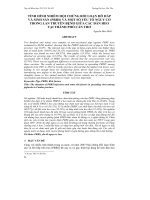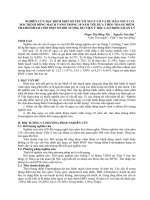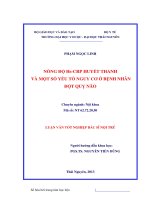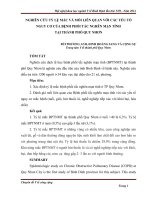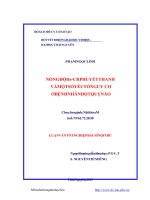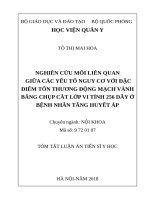Quản lý đa yếu tố nguy cơ trong dự phòng đột quỵ thứ phát tối ưu
Bạn đang xem bản rút gọn của tài liệu. Xem và tải ngay bản đầy đủ của tài liệu tại đây (4.88 MB, 64 trang )
<span class="text_page_counter">Trang 1</span><div class="page_container" data-page="1">
<b>Quản lý đa yếu tố nguy cơ trong dự phòngĐột quỵ thứ phát tối ưu</b>
<b>TS.BS. Hoàng Văn Sỹ</b>
<b>Đại học Y Dược Tp. Hồ Chí MinhKhoa Nội Tim mạch BV Chợ Rẫy</b>
</div><span class="text_page_counter">Trang 2</span><div class="page_container" data-page="2"><b><small>Feigin V et at. Lancet Neurol 2016; 15: 913–2</small></b>
<b><small>High incomeLow/Middle IncomeGloballyAge –adjusted per </small></b>
<b><small>100,000 patients years</small></b>
<b>Gắng nặng đột quỵ trên thế giới</b>
</div><span class="text_page_counter">Trang 3</span><div class="page_container" data-page="3"><b><small>3</small></b>
<b>Tử vong do đột quỵ ở châu Á cao hơn châu Âu</b>
<small>WHO, World Health Organization; DALY, disability-adjusted life year</small>
<b><small>Kim AS & Johnston SC, Circulation 2011;124:314-23</small></b>
</div><span class="text_page_counter">Trang 4</span><div class="page_container" data-page="4"><b>Đột quỵ TMCB ở Việt Nam có tỉ lệ tử vong cao</b>
</div><span class="text_page_counter">Trang 5</span><div class="page_container" data-page="5"><b>Dịch tễ học</b>
<b>Thiết kế nghiên cứu</b>
▪ US retrospective, population-based cohort study
(Framingham Heart Study) of 14,059 participants with no history of TIA, stroke.
▪ Matched cohort analysis:
➢ 435 participants with first incident TIA.
➢ 2175 control participants without TIA.
<b>Main outcome: TIA, stroke.</b>
▪ During 66-year follow-up, TIA crude incidence rate was 1.19/1000
➢ 48.5% more than 1 year later.
<b>▪ Median time to stroke: 1.64 years.</b>
▪ Adjusted cumulative 10-year hazard for stroke:
➢ 0.46 (95% CI, 0.39-0.55) for participants with TIA.
➢ 0.09 (95% CI, 0.08-0.11) for control participants without TIA.
</div><span class="text_page_counter">Trang 6</span><div class="page_container" data-page="6"><b>Nguy cơ đột quỵ tái phát tăng theo thời gian</b>
<small>a. Coull Aj, et al. BMJ 2004;328:326.b. Mohan KM, et al. Stroke 2011;42:1489-94</small>
<b>Nguycơ đột quỵ tái phát sau đột quỵ TMCB hay cơn thiếu máu não thoángqua (TIA)</b>
</div><span class="text_page_counter">Trang 7</span><div class="page_container" data-page="7"><b>Đâu là yếu tố nguy cơ quan trọng?</b>
<i><b><small>The Lancet 2020 3961223-1249DOI: (10.1016/S0140-6736(20)30752-2) </small></b></i>
</div><span class="text_page_counter">Trang 8</span><div class="page_container" data-page="8"><b>Đâu là yếu tố nguy cơ thời sự?</b>
</div><span class="text_page_counter">Trang 10</span><div class="page_container" data-page="10"><b>Các yếu tố nguy cơ gây đột quỵ tái phát</b>
<i><b><small>O’Donnell, M. J., et al. The Lancet, 2016;388(10046), 761–775.</small></b></i>
▪<b>Nghiêncứu INTERSTROKE: 13.477 bệnh nhân đột quỵ (10,388 TMCB, 3,059 XHNS) điềuchỉnh theo tuổi và giới với 13,472 người chứng khơng có đột quỵ trong 32 nước</b>
▪<b>90.5% gánhnặng đột quỵ được quy cho 10 yếu tố nguy cơ có thể điều chỉnh được</b>
<b><small>Nguyên nhân tim mạchUống rượu nhiềuĐái tháo đường</small></b><b>Cácyếu tố nguy cơ đột quỵ tái phát (OR)</b>
</div><span class="text_page_counter">Trang 11</span><div class="page_container" data-page="11"><b>Phân nhóm yếu tố nguy cơ</b>
• Ethnicity. Black higher risk compared with white
• Sex. Men higher risk than women with
exception of ages 35-44 and >85
• Family History
• Smoking- doubles stroke risk. Risk disappears 2-4 years after quitting
• HTN- most common stroke risk factor, severe HTn with increased rish for ICH
</div><span class="text_page_counter">Trang 12</span><div class="page_container" data-page="12"><b>Phòng ngừa đột quỵ thứ phát</b>
<small>Thrombosis Canada 2020 app</small>
<b>Phòngngừa thứ phát: cácbiện pháp làm giảm nguy cơ bị các biến cố mạch</b>
<b>Thrombosis Canada 2020: </b>
<b>1.Điều chỉnh lối sống2.Ngưng hút thuốc lá3.Kiểm soát HA</b>
<b>4.Điều trị chống huyết khối5.Kiểm soát lipid máu</b>
<b>6.Kiểm soát ĐTĐ</b>
<b>7.Ngưng thở khi ngủ</b>
<b>8.Kiểm sốt hẹp động mạch cảnh9. Khángđơng trong rung nhĩ</b>
<b>10.Kiểm sốt lỗ bầu dục (PFO)</b>
</div><span class="text_page_counter">Trang 13</span><div class="page_container" data-page="13"><b>Kiểm soát các yếu tố nguy cơ</b>
<b>➢ Thay đổi lối sống</b>
<b>➢ Kiểm soát cân nặng➢ Kiểm soát huyết áp</b>
<b>➢ Kiểm soát rối loạn lipid máu – nồng độ LDL-C➢ Kiểm soát đường huyết</b>
<small>Kernan WN, Ovbiagele B, Black HR, et al. Guidelines for the prevention of stroke in patients with stroke and transient ischemic attack. Stroke. 2014;45(7):2160-2236.</small>
</div><span class="text_page_counter">Trang 14</span><div class="page_container" data-page="14"><b>Thay đổi lối sống</b>
<b>INTERSTROKE: population attributable risk (PAR)</b>
<small>PAR of several risk factors for stroke in different populations</small>
<small>Adapted from O’Donnel et al., Lancet 2016</small>
</div><span class="text_page_counter">Trang 15</span><div class="page_container" data-page="15"><b>Kiểm soát cân nặng</b>
<b>➢ All patients with TIA or stroke should be screened for obesity</b>
<b>with measurement of BMI (Class I; Level of Evidence C)</b>
<b>➢ Despite the demonstrated benefcial effects of weight loss on</b>
<b>cardiovascular risk factors, the usefulness of weight lossamong patients with a recent TIA or ischemic stroke andobesity is uncertain (Class IIb; Level of Evidence C).</b>
<small>Kernan WN, Ovbiagele B, Black HR, et al. Guidelines for the prevention of stroke in patients with stroke and transient ischemic attack. Stroke. 2014;45(7):2160-2236.</small>
</div><span class="text_page_counter">Trang 16</span><div class="page_container" data-page="16"><b>Tỉ lệ cao rối loạn lipid máu ở người Việt Nam</b>
<b><small>WomanManHypertensionDiabetesOverweightDyslipidemiaSmokingDrinkingLow exercise</small><sub>Stress</sub></b>
<b><small>Metabolism Risk FactorsBehavorial Risk Factors</small></b>
<b><small>Nguyen NQ et al, 2012, Int J Hyperten 2012 doi:10.1155/2012/560397</small></b>
</div><span class="text_page_counter">Trang 17</span><div class="page_container" data-page="17"><b>Các cơ chế tác động có lợi của Statin đối với đột quỵ</b>
<b><small>Cải thiện chức năng nội mô</small></b>
<b><small>Giảm ứng suất lưu biến học máuGiảm kết tập tiểu cầu</small></b>
<b><small>Giảm huyết khối và </small></b>
<b><small>Tăng cường tình trạng tiêu sợi </small></b>
</div><span class="text_page_counter">Trang 18</span><div class="page_container" data-page="18"><b>Các nghiên cứu về phòng ngừa Đột quỵ nguyên phátvà thứ phát</b>
</div><span class="text_page_counter">Trang 19</span><div class="page_container" data-page="19"><small>Amarenco P & Labreuche J. Volume 8, Issue 5, 2009, 453–463</small>
<b>Phân tích gộp các thử nghiệm chính về statin </b>
<b>Tác động của các statin lên việc phòng ngừa đột quỵ thứ phát toàn bộ</b>
<b><small>Tổng: p<0,0001 (mức độ dị biệt: l2=7,3%, p=0,36)</small></b>
<b><small>SPARCL11,213,1HPS (bị CVD trước đây)10,310,4LIPID (bị CVD trước đây)9,513,3CARE (bị CVD trước đây)13,520,0</small></b>
</div><span class="text_page_counter">Trang 20</span><div class="page_container" data-page="20"><b>Nghiên cứu SPARCL</b>
<b><small>Pierre Amarenco, et al. N Engl J Med. 2006;355:549-59. </small></b>
<b>Đột quỵ hoặc TIA trong ≤ 6 tháng,</b>
<b><small>Tiêu chíkết cục chính: Đột quỵ tử vong/khơng tử vong</small></b>
<b><small>Tiêu chíkết cục phụ: Những biến cố mạch vành hoặc tim mạch chính</small></b>
<b><small>Theo dõi: ~5 năm (cho đến khi >540 tiêu chí kết cục chính)</small></b>
<b>Nhồi máu não hoặc TIA ở > 97% bệnh nhân</b>
</div><span class="text_page_counter">Trang 21</span><div class="page_container" data-page="21"><b>SPARCL: Kết quả tiêu chí chính</b>
<b>Điều trị với Statin liều cao giảm đột quỵ tử vong/không tử vong</b>
<b><small>Thời gian từ lúc phân ngẫu nhiên (năm)</small></b>
</div><span class="text_page_counter">Trang 22</span><div class="page_container" data-page="22"><b>SPARCL: Tác dụng giảm LDL</b>
<small>Amarenco P et al. Stroke 2007;38:3198-3204</small>
Kết cụcMức LDL (mg/dl)*Tỷ số nguy cơ (95% CI)Giá trị P
</div><span class="text_page_counter">Trang 23</span><div class="page_container" data-page="23"><b>SPARCL: Tác động của điều trị đối với đột quỵ và TIA</b>
<b><small>Tốt hơnXấu hơn</small></b>
<b><small>Pierre Amarenco, et al. N Engl J Med. 2006;355:549-59. </small></b>
</div><span class="text_page_counter">Trang 24</span><div class="page_container" data-page="24"><b>Những bằng chứng mới</b>
<b>Benefit of a target LDL cholesterol of less than 70 mg/dL after an ischemic stroke of </b>
<b>atherosclerotic origin</b>
<b>Results of the Treat Stroke to Target trial*</b>
Amarenco P, Kim JS, Labreuche J, Charles H, Giroud M, Mahagne M-H, Nighoghossian N, Steg PG, Touboul PJ, Vicaut E, Bruckert E on behalf of the
Treat Stroke to Target investigators
<small>*Investigator intiated RCT</small>
<small>Conducted by the Charles Foix Group for Clinical Trial in Stroke (ARO) at Bichat hospital – University of ParisSupported by the French Neurovascular Society</small>
<small>Funding : PHRC (French government), SOS-ATTAQUE CEERBRALE Association (NPO)Unrestricted grant : Pfizer Europe, Astra-Zeneca, Merck, Pfizer global (Korea)</small>
<small>Amarenco P, Kim JS, Labreuche J, et al. A Comparison of Two LDL Cholesterol Targets after Ischemic Stroke. N Engl J Med. 2020;382(1):9</small>
</div><span class="text_page_counter">Trang 25</span><div class="page_container" data-page="25">with evidence of atherosclerosis
CRAs in the trial unit contacted with patients 3 months before the next visit, making sure they were treated to the assigned target
Titration of lipid lowering treatment
Investigators used statin and dose of their choice in monotherapy or in combination with ezetimide or other drugs
Patients and investigators were not maintained blinded but the adjudication committee was fully blinded 1:1
</div><span class="text_page_counter">Trang 26</span><div class="page_container" data-page="26">• Follow-up visits occurred every 6 months
• The number of center was 61 in France, 16 in Korea (joined the trial in late 2015)
• <b>Trial was stopped on May 25, 2019 after allocatedfunds have been used, with 277 primary</b>
</div><span class="text_page_counter">Trang 27</span><div class="page_container" data-page="27"><b>Nghiên cứu TST: mức độ giảm LDL-C</b>
<small>Amarenco P, Kim JS, Labreuche J, et al. A Comparison of Two LDL Cholesterol Targets after Ischemic Stroke. N Engl J Med. 2020;382(1):9</small>
</div><span class="text_page_counter">Trang 28</span><div class="page_container" data-page="28"><small>. Entry event (ischemic stroke vs. TIA). Time from symptom onset to </small>
<small>. Geographical region (France vs Korea)(SPARCL trial adjustment)</small>
<small>Adjusted HR = 0.78 [95% CI: 0.61 to 0.98; P value = 0.036]Non adjusted HR = 0.77 [95% CI; 0.61-0.97; P value = 0.029]</small>
<b>Ischemic stroke or undetermined stroke, myocardial infarction, urgent coronary revascularizationfollowing unstable angina, urgent carotid revascularization following TIA, vascular death</b>
<b>22% RRR</b>
<b>Tiêu chí chính của nghiên cứu TST</b>
<small>Amarenco P, Kim JS, Labreuche J, et al. A Comparison of Two LDL Cholesterol Targets after Ischemic Stroke. N Engl J Med. 2020;382(1):9</small>
</div><span class="text_page_counter">Trang 29</span><div class="page_container" data-page="29"><small>myocardial infarction and urgent coronary </small>
<small>revascularization</small> <sup>20/1430 (1.4)</sup> <sup>31/1430 (2.2)</sup> <sup>0.64 (0.37-1.13)</sup> <sup>0.12*</sup> <small>cerebral infarction and urgent carotid and cerebral artery </small>
<small>revascularization</small> <sup>88/1430 (6.2)</sup> <sup>109/1430 (7.6)</sup> <sup>0.81 (0.61-1.07)</sup> <small>cerebral infarction or TIA120/1430 (8.4)139/1430 (9.7)0.87 (0.68-1.11)any revascularization procedure (both urgent and all cause death88/1430 (6.2)93/1430 (6.5)0.97 (0.73-1.30)Cerebral infarction or intracranial hemorrhage103/1430 (7.2)126/1430 (8.8)0.82 (0.63-1.07)</small>
<b><small>Primary outcome or intracranial hemorrhage133/1430 (9.3)165/1430 (11.5)0.80 (0.63-1.00)</small></b>
* Hierarchical testing stopped
<b>Secondary Outcomes</b>
<sup>LDL <70 mg/dL </sup><sub>(N=1430)</sub> <sup>LDL 100±10 mg/dL</sup><sub>(N=1430)</sub> <sup>Hazard Ratio</sup><sub>(95% CI)</sub> <small>P Value</small><b>Tiêu chí phụ trong nghiên cứu TST</b>
<small>Amarenco P, Kim JS, Labreuche J, et al. A Comparison of Two LDL Cholesterol Targets after Ischemic Stroke. N Engl J Med. 2020;382(1):9</small>
</div><span class="text_page_counter">Trang 30</span><div class="page_container" data-page="30">• With the limitation that we had to stop the trial when 277 primary endpoints were accrued whereas 385 were requested
• This trial shows that after an ischemic stroke with evidence of atherosclerosis, a target LDL cholesterol ofless than 70 mg/dL(1.8 mmol/L) compared to 100± 10 mg/dL (2.5 mmol/L),reduced the risk of subsequent cardiovascular events
• With no significant increase in intracranial hemorrhage • And no increase in newly diagnosed diabetes
<b>Thông điệp từ nghiên cứu TST</b>
<small>Amarenco P, Kim JS, Labreuche J, et al. A Comparison of Two LDL Cholesterol Targets after Ischemic Stroke. N Engl J Med. 2020;382(1):9</small>
</div><span class="text_page_counter">Trang 32</span><div class="page_container" data-page="32"><b>Hướng dẫn phòng ngừa đột quỵ thứ phát</b>
<b>Rối Loạn Lipid Máu</b>
<b><small>Khuyến CáoPhân Loại/Mức Độ Bằng Chứng</small></b>
<b><small>Liệu pháp Statin cường độ mạnhđược khuyến cáo để làm giảm nguy cơ độtquỵ và các biến cố tim mạch ở bệnh nhân bịđột quỵ thiếu máu hoặc TIA do xơvữa động mạchvà cómức LDL-C ≥ 100 mg/dL kèm hoặc khơng có bằng chứngcủa bệnh tim mạch do xơ vữa (ASCVD) nào khác trên lâm sàng</small></b>
<b><small>Phân loại I, Mức độ B</small></b>
<b><small>Liệu pháp Statin cường độ mạnhđược khuyến cáo để làm giảm nguy cơ độtquỵ và các biến cố tim mạch ở bệnh nhân bịđột quỵ thiếu máu hoặc TIA do xơvữa động mạchvà cómức LDL-C < 100 mg/dL kèm hoặc khơng có bằng chứngcủa ASCVD nào khác trên lâm sàng</small></b>
<b><small>Phân loại I, Mức độ B</small></b>
<b><small>Bệnh nhân bị đột quỵ thiếu máu hoặc TIA và ASCVD đi kèm bệnh khác nên đượcxử trí theo hướng dẫn ACC/AHA 2013 về cholesterol, bao gồm sự điều chỉnh lốisống, các khuyến cáo về chế độ ăn kiêng và các khuyến cáo dùng thuốc</small></b>
<b><small>Phânloại I, Mức độ A</small></b>
<small>Kernan WN, Ovbiagele B, Black HR, et al. Guidelines for the prevention of stroke in patients with stroke and transient ischemic attack. Stroke. 2014;45(7):2160-2236.</small>
</div><span class="text_page_counter">Trang 33</span><div class="page_container" data-page="33"><b>“Điều trị statin tích cực được khuyến cáo nhằm giảm nguy cơ đột quỵ và biếncố tim mạch trên BN đột quỵ do thiếu máu cục bộ và cơn thoáng thiếu máu não” </b>
<i><b>(Class I; Level of Evidence B)</b></i>
<b>“ </b>
<b>Mục tiêu điều trị giảm ít nhất 50% LDL-C hoặc kiểm soát mức LDL-C < 70 mg/dL giúp mang lại hiệu quả tối ưu cho BN” </b><i><b>(Class IIa; Level of Evidence B) </b></i>
<i><b>(New recommendation)</b></i>
<b>Hướng dẫn phòng ngừa đột quỵ</b>
</div><span class="text_page_counter">Trang 34</span><div class="page_container" data-page="34"><b>Khuyến cáo điều chỉnh lipid máu trong phòng ngừa thứ phát</b>
<b><small>Francois Mach, et al. European Heart Journal (2019) 00, 1-78 </small></b>
</div><span class="text_page_counter">Trang 35</span><div class="page_container" data-page="35"><b>Nguy cơ tim mạch rất cao</b>
<b><small>Francois Mach, et al. European Heart Journal (2019) 00, 1-78 </small></b>
</div><span class="text_page_counter">Trang 36</span><div class="page_container" data-page="36"><b>Điều chỉnh LDL-C bằng thuốc</b>
<b><small>Francois Mach, et al. European Heart Journal (2019) 00, 1-78 </small></b>
<b>Statinvẫn là thuốc đầu tay trong điều chỉnh lipid máu</b>
</div><span class="text_page_counter">Trang 37</span><div class="page_container" data-page="37"><b>Liều statin trong phòng ngừa thứ phát bệnh tim mạch</b>
</div><span class="text_page_counter">Trang 38</span><div class="page_container" data-page="38"><b>Kiểm soát đường huyết</b>
<b>➢ After a TIA or ischemic stroke, all patients should probably be screened for DM with</b>
<b>testing of fasting plasma glucose, HbA1c, or an oral glucose tolerance test. Choiceof test and timing should be guided by clinical judgment and recognition that acuteillness may temporarily perturb measures of plasma glucose. In general, HbA1c maybe more accurate than other screening tests in the immediate postevent period(Class IIa; Level of Evidence C).</b>
<b>➢ Use of existing guidelines from the ADA for glycemic control and cardiovascular risk</b>
<b>factor management is recommended for patients with an ischemic stroke or TIA whoalso have DM or pre-DM (Class I; Level of Evidence B).</b>
<small>Kernan WN, Ovbiagele B, Black HR, et al. Guidelines for the prevention of stroke in patients with stroke and transient ischemic attack. Stroke. 2014;45(7):2160-2236.</small>
</div><span class="text_page_counter">Trang 39</span><div class="page_container" data-page="39"><b>Kiểm soát đường huyết</b>
<b><small>Kernan WN, et al. N Engl J Med 2016;374:1321-31</small></b>
<b>Thử nghiệm IRIS </b>
</div><span class="text_page_counter">Trang 40</span><div class="page_container" data-page="40"><b><small>Kernan WN, et al. N Engl J Med 2016;374:1321-31</small></b>
<b>Thử nghiệm IRIS </b>
</div><span class="text_page_counter">Trang 41</span><div class="page_container" data-page="41"><b>Trial design: Patients without diabetes with a history of stroke or TIA within 6 months, with objective evidence of insulin</b>
resistance (HOMA-IR value >3.0), were randomized to either pioglitazone 45 mg or placebo. They were followed for 4.8 years.
<b><small>Kernan WN, et al. N Engl J Med 2016;374:1321-31</small></b>
<b><small>Primary endpoint</small></b>
➢ Pioglitazone was superior to placebo in reducing the composite of stroke/MI in patients with recent stroke/TIA, no history of DM2, and objective evidence of insulin resistance
➢ There was an increase in previously described side effects with TZDs, including bone fractures, edema, and weight gain
<b><small>(p = 0.007)</small></b>
<b>Thử nghiệm IRIS </b>
</div><span class="text_page_counter">Trang 42</span><div class="page_container" data-page="42"><b>Tăng huyết áp</b>
<b>➢ Tăng huyết áp góp phần thúc đẩy xơ vữa và là yếu tố nguy</b>
<b>cơ quan trọng nhất của đột quỵ.</b>
<b>➢ 70% bệnh nhân bị đột quỵ có ghi nhận tình trạng tăng</b>
<b>huyết áp</b>
<b>➢ Các yếu tố khác liên quan đến con số huyết áp của bệnh</b>
<b>nhân cũng được chứng minh có mối liên quan với đột quỵbao gồm huyết áp trung bình, độ chênh áp, biến thiênhuyết áp và mất trũng huyết áp về đêm.</b>
<small>Kernan WN, Ovbiagele B, Black HR, et al. Guidelines for the prevention of stroke in patients with stroke and transient ischemic attack. Stroke. 2014;45(7):2160-2236.</small>
</div><span class="text_page_counter">Trang 43</span><div class="page_container" data-page="43"><b><small>Sarah Lewington, et al. Lancet 2002;360:1903–13.</small></b>
<b>Tử vong do đột quỵ tăng khi huyết áp càng cao</b>
<b>Phân tíchtổng hợp trên 1 triệungười của 61 nghiên cứu tiềncứu</b>
<b>Tử vong do đột quỵ tăng theo:</b>
<b>• Tuổi</b>
<b>• Trị số huyết áp</b>
</div><span class="text_page_counter">Trang 44</span><div class="page_container" data-page="44">•<b>123 nghiêncứu ngẫu nhiên nhóm chứng về điều trị hạ huyết áp</b>
•<b>Ítnhất 1000 bệnh nhân-năm theo dõi mỗi nhánh</b>
•<b>613 815 bệnh nhân</b>
<small>*Epidemiologic studies, not clinical trials of HTN agents.BP, blood pressure; IHD, ischemic heart disease.</small>
<b>Lợi ích của điều trị giảm huyết áp đã được khẳng định</b>
<b><small>Dena Ettehad, et al. The Lancet, 2016;387: 957-967; DOI: 10.1016/S0140-6736(15)01225-8</small></b>
</div><span class="text_page_counter">Trang 45</span><div class="page_container" data-page="45"><b>Các thử nghiệm về tăng huyết áp sau đột quỵ</b>
<b>Những thử nghiệm lớn về vai trị của kiểm sốt huyết áp sauđột quỵ</b>
<b>➢ 5665 patients with a recent TIA or minor stroke</b>
<b>(hemorrhagic or ischemic) to indapamide or placebo</b>
<b>➢ The main outcome of recurrent stroke was observed in</b>
<b>44.1% of patients assigned to placebo and 30.9% of thoseassigned to indapamid</b>
<small>Kernan WN, Ovbiagele B, Black HR, et al. Guidelines for the prevention of stroke in patients with stroke and transient ischemic attack. Stroke. 2014;45(7):2160-2236.</small>
</div><span class="text_page_counter">Trang 46</span><div class="page_container" data-page="46"><b>Những thử nghiệm lớn về vai trò của kiểm soát huyết áp sauđột quỵ</b>
<b>➢ Perindopril Protection Against Recurrent Stroke Study</b>
<b>➢ 6105 patients with a history of TIA or stroke (ischemic or</b>
<b>hemorrhagic) to active treatment with a perindopril-base regimen or placebo</b>
<b>➢ Active therapy reduced the primary end point of fatal or</b>
<b>nonfatal stroke by 28%</b>
<small>Kernan WN, Ovbiagele B, Black HR, et al. Guidelines for the prevention of stroke in patients with stroke and transient ischemic attack. Stroke. 2014;45(7):2160-2236.</small>
<b>Các thử nghiệm về tăng huyết áp sau đột quỵ</b>
</div><span class="text_page_counter">Trang 47</span><div class="page_container" data-page="47"><small>Cochrane Database of Systematic Reviews 2018, Issue 7. Art. No.: CD007858.</small>
<b>Dữ liệu từ phân tích gộp</b>
</div><span class="text_page_counter">Trang 48</span><div class="page_container" data-page="48"><small>Cochrane Database of Systematic Reviews 2018, Issue 7. Art. No.: CD007858.</small>
</div><span class="text_page_counter">Trang 49</span><div class="page_container" data-page="49"><b>Thuốc hạ áp và mức huyết áp tối ưu</b>
<small>Cochrane Database of Systematic Reviews 2018, Issue 7. Art. No.: CD007858.</small>
</div><span class="text_page_counter">Trang 50</span><div class="page_container" data-page="50"><i><b><small>Aristeidis H. Katsanos, et al. Hypertension. 2017;69:171-179</small></b></i>
<b>Kiểm sốt huyết áp ở bệnh nhân có tiền căn đột quỵ</b>
<b>14 nghiêncứu đạt yêu cầu:</b>
<b>• Được xem xét độc lập bởi 2 nhà nghiên cứu• Thử nghiệm ngẫu nhiên (RCT)</b>
<b>• Điều trị thuốc hạ áp phịng ngừa thứ phát đột quỵ• Báo cáo trị số HA trong theo dõi</b>
</div><span class="text_page_counter">Trang 51</span><div class="page_container" data-page="51"><i><b><small>Aristeidis H. Katsanos, et al. Hypertension. 2017;69:171-179</small></b></i>
<b>Điều trị thuốc hạ áp giảm nguy cơ đột quỵ tái phátvà tử vong tim mạch</b>
<b>Đột quỵ tái phát</b>
<b>Tử vong tim mạch</b>
</div>